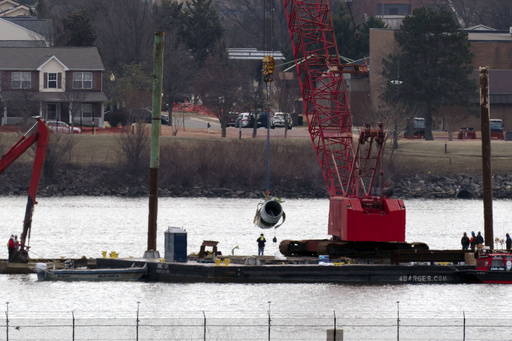ARLINGTON, Va. — Recovery teams successfully removed a significant section of a commercial aircraft from the Potomac River near Washington D.C.’s Reagan National Airport on Monday, following a tragic midair collision that resulted in the deaths of 67 individuals just five days prior.
Authorities have indicated that the recovery process will be prolonged, as they intend to remove the military helicopter that was also involved in the accident once the plane is fully extracted.
The unfortunate collision, which involved an American Airlines flight and an Army Black Hawk helicopter, marks the deadliest aviation disaster in the United States since 2001. So far, emergency teams have successfully identified 55 of those who perished in the incident, with officials expressing confidence that all victims will eventually be accounted for. Crews working on the recovery were seen operating crane-equipped vessels early on Monday.
Over 300 responders have participated in the recovery operation, and two Navy barges have been dispatched to assist in lifting heavy pieces of wreckage from the water. Divers and salvage personnel are adhering to stringent safety protocols; they have been instructed to cease any debris removal efforts should human remains be discovered, as Col. Francis B. Pera of the Army Corps of Engineers emphasized the importance of a “dignified recovery.”
Wreckage from both of the aircraft involved in the collision—an American Airlines plane carrying 64 passengers and crew and the Army helicopter with three personnel on board—is being transported via flatbed trucks to a hangar for further examination. The aircraft collided as the commercial flight was approaching for landing from Wichita, Kansas, while the helicopter was conducting a training operation. No survivors emerged from this tragic event.
On Sunday, family members of the victims were escorted by police to the bank of the Potomac, not far from where the wreckage settled after the crash. Among the passengers on the airline were figure skaters returning from the 2025 U.S. Figure Skating Championships and a group of hunters. The helicopter’s crew included Army Staff Sgt. Ryan Austin O’Hara, Chief Warrant Officer 2 Andrew Loyd Eaves, and Capt. Rebecca M. Lobach.
Federal authorities are currently working to reconstruct the circumstances that led to the collision. Typically, detailed investigations can extend beyond a year; however, they aim to compile a preliminary report within the next 30 days.
This aerial mishap is notably the deadliest since November 12, 2001, when a jetliner crashed into a residential area of New York City shortly after takeoff, resulting in the loss of 260 lives on board as well as five on the ground.
Experts maintain that air travel is remarkably safe, though navigating the crowded airspace surrounding Reagan Airport can pose challenges even for seasoned pilots. The National Transportation Safety Board (NTSB) noted preliminary data revealing discrepancies between the altitude readings of the American Airlines aircraft and the helicopter.
Investigators reported that approximately one second before impact, data from the jet’s flight recorder indicated a change in pitch, though it remains unclear if this suggests the pilots were attempting an evasive maneuver. The flight data revealed the jet’s altitude at approximately 325 feet at the time of collision, while control tower data registered the helicopter at 200 feet, which is the maximum allowable altitude for helicopters in that region.
The reasons behind this discrepancy are still being evaluated. The NTSB is working to reconcile the differing results using data from the helicopter’s black box and plans to refine the tower data, which can be less reliable.




